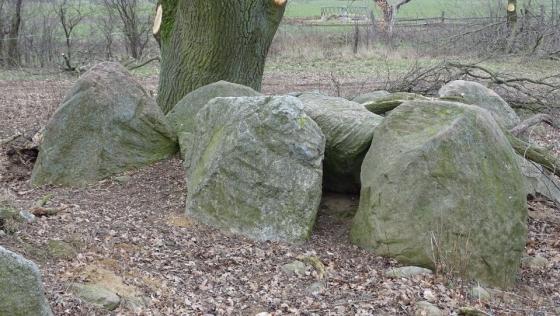taken from the “Archäologisch-historischer Wanderweg Lüdelsen (2)” information board:
Megalithic tomb Lüdelsen site 3
Construction: Funnel Beaker Culture (around 3550 BC);
Burials: Funnel Beaker Culture 3550-3200 BC;
Secondary burials: Single-Grave culture (2400 BC)
The construction of this site with burial chamber, a double or three-row stone embankment and the first mound was around 3550 BC. The chamber construction (inner height approx. 1.0 m) consisted of two capstones, seven support stones for the actual burial chamber and two more for the entrance. The gaps between the stones were filled with split wedge-shaped granite stones (dry-stone walling). The outer joints were carefully closed with 2-5 cm, smashed flint fragments. The larger splinters between chamber and entrance stones filled the builders with simple field stones. The two stone enclosures, built at the same time, formed with the entrance stones a court in front of the chamber, delimited to the outside by a freestanding menhir. The inner stone encirlce formed the boundary of the first, older mound. It reached to the lower edge of the capstones, which remained uncovered and visible. Finds (broken pieces and a cross-cutting arrowhead) from the non-paved chamber floor are from the first burials (Funnel Beaker Culture). The last funeral took place around 2400 BC (Single-Grave culture). In this context, a second mound of almost 30 m in diameter was built up, which completely covered the first mound and both stone enclosures. The capstones, however, were still visible. Since that time the chamber remained undisturbed. Findings from the area around the tomb prove that the people visited the site in the Bronze and Iron Age again and again.
After the complete excavation in 2007, the megalithic grave was rebuilt in 2008 on the basis of the excavation plans.












































